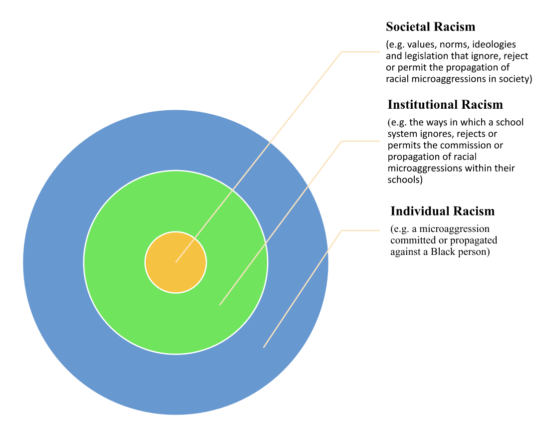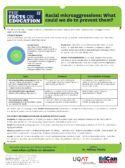Racial microaggressions: what could we do to prevent them?
Download the Fact Sheet! (335.73 kB / pdf)
DownloadThis educational sheet is intended for educators who want to understand what systemic racism is and how racial microaggressions are examples of such racism.
SYSTEMIC RACISM
Societal, institutional and individual racism collectively constitute systemic racism. Systemic racism results not only from the interplay of these three types of racism, but also from the ways in which they intertwine and overlap. Although some people might think that a racial microaggression is simply an example of individual racism, this is not the case (Jean-Pierre and Villella, 2022).

Please note: Linguicism, also called language discrimination, is not racism, i.e. racial discrimination. However, an Indigenous, Black or racialized person can experience racialized linguicism because of his or her accent (Jean-Pierre and Villella, 2022).
RACIAL MICROAGGRESSION: A brief daily indignity involving racist comments or racial slurs uttered or repeated against Black or racialized people. This table shows the three main categories of microaggressions: microinvalidations, microinsults and microassaults (Sue et al., 2007).
| TYPES | EXAMPLES | CONTEXTUALIZED MESSAGES |
| Microinsults (often unconscious): making judgments about a Black person’s values and communication style, for example, when he or she is teaching in a classroom of predominantly white students. | “You speak too loudly/you don’t speak loudly enough. Here, if you want children to listen to you, you have to…” | A Black person must assimilate to the values or norms of the dominant group, i.e. the white elite, or suffer the consequences on his or her career. |
| Microassaults (often conscious): expressly denigrating a Black person. | A white person insists that it is okay to use the N word and then repeats this word while looking at a Black person to reinforce his or her point. | Black people’s racial identity and experience do not matter. |
| Microinvalidation (often unconscious): denying that a Black person has experienced racism. | “I don’t think that’s actually racism. The principal just says that to all new teachers.” | A Black person’s experience of racism is nullified as being legitimate. |
The manifestation of a microaggression, whether conscious or not, is more than an example of individual racism. Its foundations can be traced to institutional racism as well as societal racism, i.e. to systemic anti-Black racism.
PRELIMINARY RECOMMENDATIONS FOR UNLEARNING SYSTEMIC RACISM
- Recognize all Indigenous nations, i.e. First Nations, Inuit and Métis, by mentioning their past and present history on a daily basis, without limiting their participation in French-language schools based on their ability to speak French. This means that white people of both official language communities must stop calling themselves the only or the first inhabitants to reside in the land now called Canada.
- Admit that, in both official language communities, power most often rests in the hands of white people. Statistical data shows this and research highlights its effects.
- Share your positive appreciation for Black identity and for the history – past and current – of Black communities in Canada. It is important for all aspects of the school system to recognize that the history of Black people is an integral part of Canada’s history.
- Accept that systemic racism exists and has a real, current and historical impact on Black people – even those born in this country – more than on other visible minorities, because of their phenotype or skin colour. The problem is therefore not limited to the experience of Black immigrants.

